Banner campaign
Latest
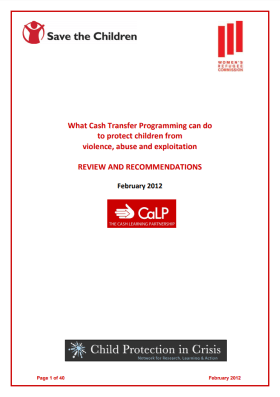
What Cash Transfer Programming can do to Protect Children from Violence, Abuse and Exploitation – Review and recommendations
Report
This discussion paper examines the links between cash transfers and the positive and negative outcomes for children, in particular the role cash transfers have played in protecting children from harm, exploitation, abuse and violence. The objective of this paper is to identify ways in which cash transfer...
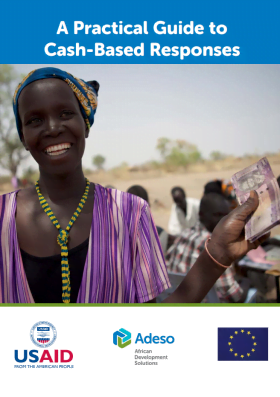
A Practical Guide to Cash-Based Response
Guidelines and Tools
A Practical Guide to Cash-based Responses is a manual developed by Adeso to share the organisation’s experience in developing and implementing appropriate cash-based responses. The manual highlights some practical problems that are faced by implementation teams around the world and it is intended to...

Mobile Technology in Emergencies
Policy paper
Mobile phones are increasingly accessible to those affected by crisis and can play a strategic role in the delivery of rapid, cost-effective, scalable humanitarian assistance. However, the full potential of mobile phones to work as transformative tools in emergency response has not yet been realised. This...
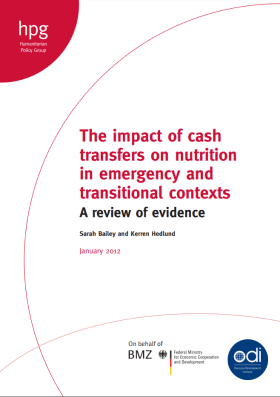
The Impact of Cash Transfers on Nutrition in Emergency and Transitional Contexts – Review of evidence
Report
This ODI / HPG commissioned report reviews the evidence of the impact of cash transfers on nutrition in emergency and transitional contexts. The research finds that evidence from humanitarian evaluations makes a strong case that cash transfers often improve dietary intake. There is less evidence that cash...
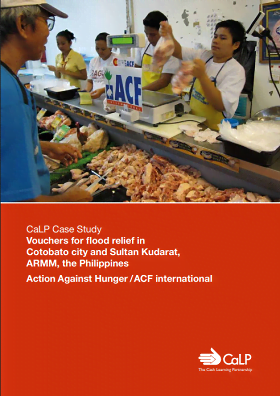
Vouchers for Flood Relief in Cotobato City and Sultan Kudarat, ARMM (Mindanao), the Philippines
Case Study
In response to a rapid-onset emergency, Action Against Hunger / ACF International, with funding from AECID, implemented a cash transfer program in Cotobato City, situated in the Autonomous Region of Muslim Mindanao in the Philippines. The project established a cash voucher program through local...
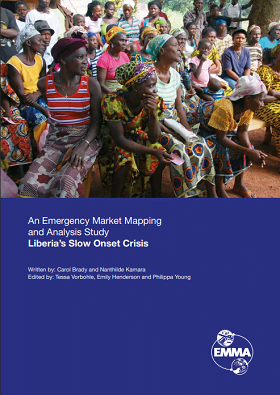
An Emergency Market Mapping and Analysis Study Liberia’s Slow Onset Crisis
Report
In 2010, contested elections in neighbouring Côte d’Ivoire, and the violence that ensued, forced hundreds of thousands of people from their homes. As of 7th of July 2011, the United Nations High Commissioner for Refugees (UNHCR) had counted a total of 153,000 refugees crossing the border into Liberia....
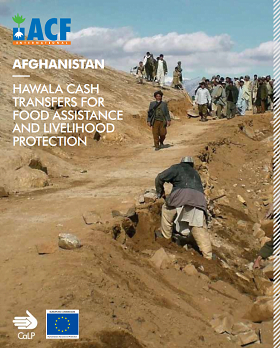
Afghanistan: Hawala cash transfers for food assistance and livelihood protection
Case Study
In response to repeated flooding, ACF implemented a cash-based intervention in the Samangan and Day Kundi Provinces of Afghanistan. The project applied cash for work activities as well as unconditional cash transfers and made use of the local Hawala system to securely transfer money to beneficiaries. The...

Logistics and Administration Guideline for Cash Based Interventions
Guidelines and Tools
Cash-based interventions (CBIs) are increasingly included in humanitarian relief efforts as alternatives or complements to in-kind assistance. This guideline is mainly dedicated to logisticians and administrators to successfully support CBIs but also to technical departments. The objectives of this...

An Emergency Market Mapping and Analysis study Market Support in South Sudan
Report
Abyei is a relatively small and disputed area of land on the border of North and South Sudan that has, in recent years, experienced much turmoil. Historically, both the governments of South and North Sudan have claimed Abyei and tensions that have existed since before the first Sudanese Civil War...

Kenya: Cash grants to support post-election violence livelihood recovery
Case Study
In response to post-election violence starting in late December 2007, ACF implemented a cash-based intervention in Nakuru, South Rift Valley, Kenya. This programme supported the local displaced and host population, who had been excluded from aid provided to internally displaced persons (IDPs) living in...

New Technologies in Cash Transfer Programming and Humanitarian Assistance
Report
This study was commissioned by the the CALP Network in 2011, to review the current use of new technology in humanitarian cash and voucher programming and the broader implications for humanitarian practice. The research was undertaken to explore (i) preconditions for the use of technological...
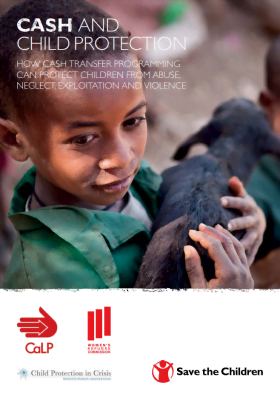
Cash and Child Protection: How cash transfer programming can protect children from abuse, neglect, exploitation and violence
Guidelines and Tools
This discussion paper examines the links between cash transfers and the positive and negative outcomes for children – in particular, the role cash transfers have played in protecting children from abuse, neglect, exploitation and violence. It aims to identify ways in which cash transfer activities could...
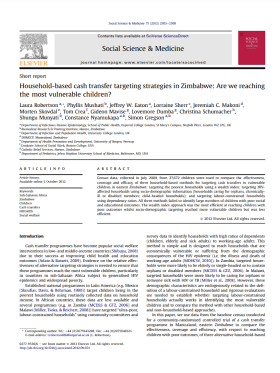
Household-Based Cash Transfer Targeting Strategies in Zimbabwe: Are we reaching the most vulnerable children?
Report
Census data, collected in July 2009, from 27,672 children were used to compare the effectiveness, coverage and efficacy of three household-based methods for targeting cash transfers to vulnerable children in eastern Zimbabwe: targeting the poorest households using a wealth index; targeting HIV affected...
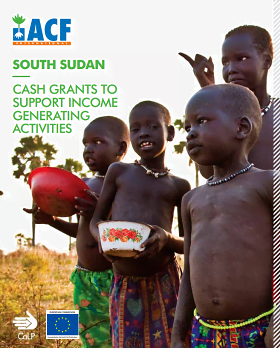
South Sudan: Cash grants to support income generating activities
Case Study
In response to chronic malnutrition, ACF implemented a cash-based intervention in Twic and Gogrial West Counties of Warrap State, South Sudan, using group cash grants to promote income generating activities. The programme addressed chronic livelihood vulnerability, which is a contributing factor to global...

New Technologies in Cash Transfer Programming and Humanitarian Assistance – Executive Summary
Report
This is the executive summary of the CALP Network’s research on new technologies in cash transfer programming and humanitarian assistance. For more, please see the full report.

Child Safeguarding in Cash Transfer Programming
Guidelines and Tools
While cash transfers have become a key intervention in emergencies, they also pose increased and additional risks for beneficiaries, compared with other forms of assistance. Children are particularly vulnerable, and even more so in emergencies. The impact of cash transfer programming on children’s...
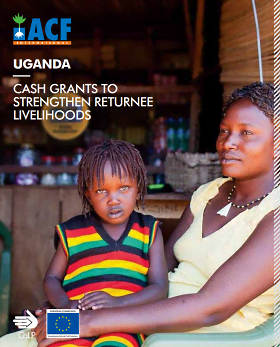
Uganda: Cash grants to strengthen returnee livelihoods
Case Study
In support of the return and recovery effort of formerly war affected populations, ACF implemented a cash-based intervention in Otuke District of Northern Uganda. This programme assisted internally displaced persons (IDPs) with the return home and re-establishing their livelihoods. Vulnerable households...
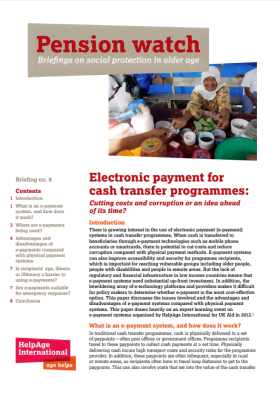
Pension Watch Briefing #8: Electronic payment for cash transfer programmes
Policy paper
There is growing interest in the use of electronic payment (e-payment) systems in cash transfer programmes. When cash is transferred to beneficiaries through e-payment technologies such as mobile phone accounts or smartcards, there is potential to cut costs and reduce corruption compared with physical...
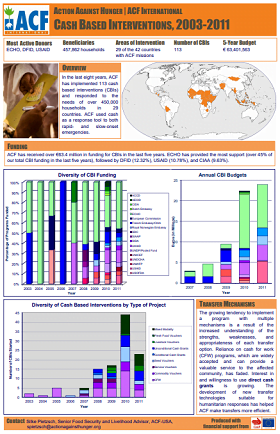
ACF Cash-based Interventions 2003-2011 (Poster)
Report
A one-pager / poster showing ACF’s cash-based interventions between 2003-2011, showing source of funding and type of intervention.
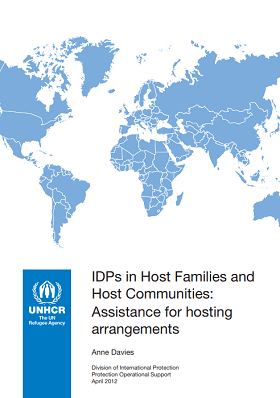
IDPs in Host Families and Host Communities: Assistance for Hosting Arrangements
Report
The phenomenon of internally displaced persons (IDPs) and refugees residing with host families is still relatively unexplored in comparison to what is known about IDPs and refugees living in camps. Of the nearly 14.7 million IDPs protected and assisted by UNHCR in 2010, an estimated 52% of the total live...